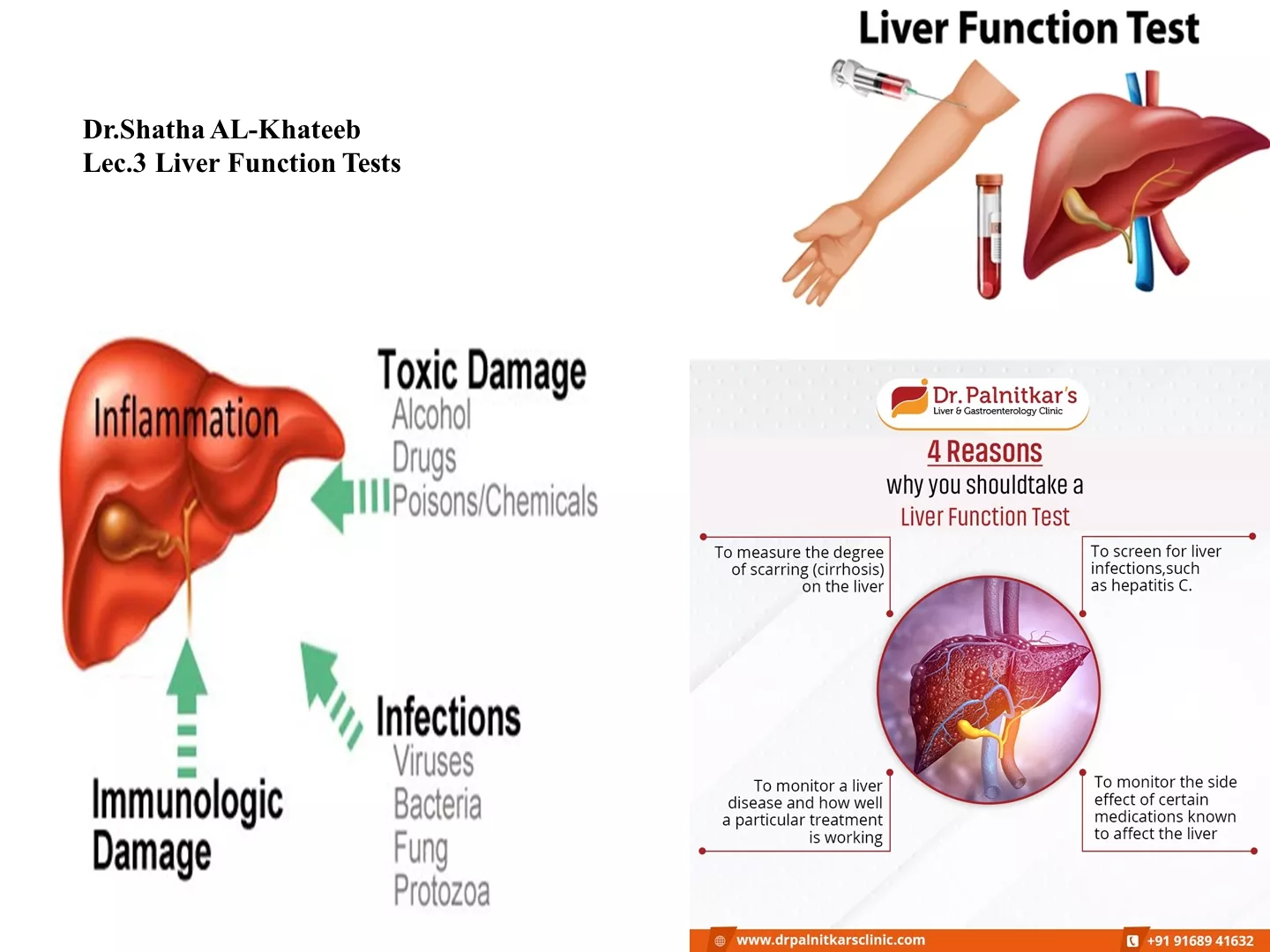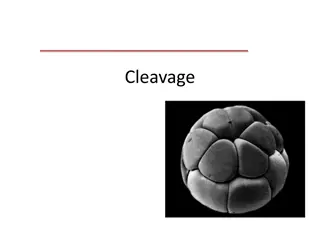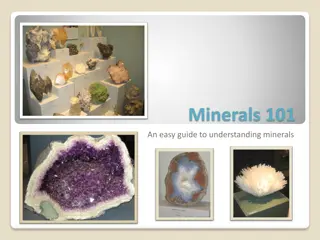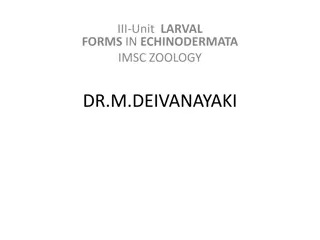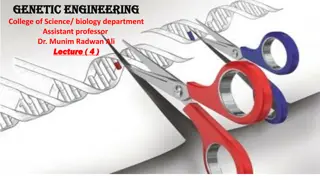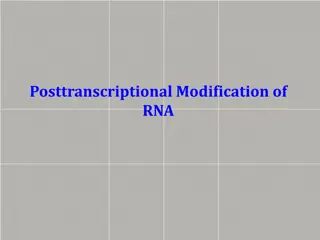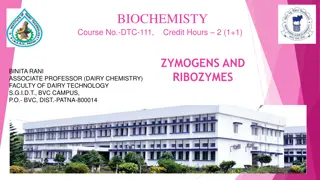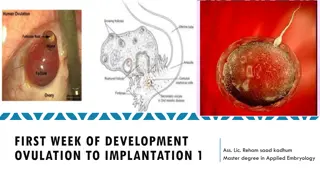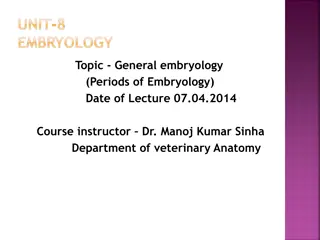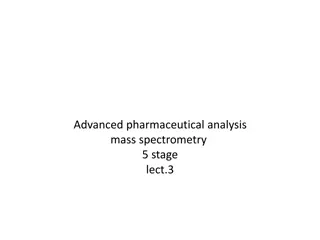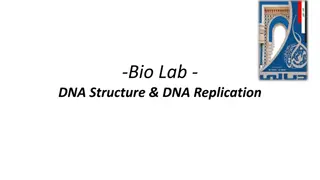CLEAVAGE
Cleavage is a vital process involving rapid cell divisions in a zygote to form the building blocks of an offspring. This detailed guide explores the characteristics, phases, and differences with somatic cell cycles, shedding light on the intricate mechanisms governing early embryonic development.
Download Presentation

Please find below an Image/Link to download the presentation.
The content on the website is provided AS IS for your information and personal use only. It may not be sold, licensed, or shared on other websites without obtaining consent from the author.If you encounter any issues during the download, it is possible that the publisher has removed the file from their server.
You are allowed to download the files provided on this website for personal or commercial use, subject to the condition that they are used lawfully. All files are the property of their respective owners.
The content on the website is provided AS IS for your information and personal use only. It may not be sold, licensed, or shared on other websites without obtaining consent from the author.
E N D
Presentation Transcript
CLEAVAGE Dr.Lubal M.J. Research Guide Head Dept.of Zoology Dahiwadi College Dahiwadi (B.Sc.lll)
DEFINITION : DEFINITION : Cleavage is a process of rapid and synchronous mitotic cell divisions of the zygote to form numerous cells for building up the offspring s body Cleavage differs from other forms of cell division in that it increases the number of cells without increasing the mass. Cleavage ends with the formation of the blastula.
CHARACTERISTICS OF CLEAVAGE: CHARACTERISTICS OF CLEAVAGE: All the divisions of the zygote are mitotic and occurs in quick succession. Interphase Interphase in cleavage divisions is very short and does not involve of growth so that the resulting blastomeres becomes smaller in size as their number increases. The total cytoplasmic mass remains the same cytoplasmic mass remains the same as in the zygote. Cleavage divisions clearly differs from the ordinary mitotic Cleavage divisions clearly differs from the ordinary mitotic divisions divisions in which the daughter cells grow to normal size before the next division can occur.
SOMATIC CELL CYCLE: SOMATIC CELL CYCLE:
Somatic cell cycle Somatic cell cycle contains 4 phases: G1, S, G2 and M . G1, S, G2 and M . The cleavage cell cycle cleavage cell cycle comprises only 2 phases : M and S. M and S. M and S phases of cleavge cell cycle are shorter than those of somatic cell cycle. The ratio of nuclear mass to cytoplasmic mass is very low for the zygote . During cleavage nuclear material increases as the new nucleus is formed for each blastomere as a results nuclear/cytoplasmic ratio increases.This makes a cell more active metabolically. nuclear/cytoplasmic ratio
Shape of the embryo does not change Shape of the embryo does not change during cleavage because there is no movement of blastomeres. Early cleavage is regular and synchronous cleavage is regular and synchronous i.e. all the blastomeres divides simultaneously. With the result no. of blastomeres doubles{2,4,8,16,32,64} blastomeres doubles{2,4,8,16,32,64} at each cleavage. Cleavage becomes irregular so that the blastomeres no longer double at regular interphase. In amphibians In amphibians there is an abrupt change in the duration and synchrony of the cell cycle which is called mid transistion{MBT}. transistion{MBT}. mid- -blastula blastula DNA synthesis occurs faster DNA synthesis occurs faster during cleavage to facilitate duplication of chromosomes for rapid cell divisions.
DOUBLING OF BLASTOMERES: DOUBLING OF BLASTOMERES:
Cleavage besides producing a large no. of cells by rapid divisions also seggregates different substances seggregates different substances present n the cytoplasm of the zygote into different cells. Consumption of oxygen greatly increases Consumption of oxygen greatly increases during cleavage to provide adequate energy for the activity taking place in the cell diviosion. The blastomeres remains adhered blastomeres remains adhered together during cleavage.
SYNTHESIS OF NUCLEIC ACID IN CLEAVAGE: The chemical composition of embryo does not undergoes any The chemical composition of embryo does not undergoes any qualitative change during cleavage. qualitative change during cleavage. The amount of DNA increases since there is rapid increase in The amount of DNA increases since there is rapid increase in number of nuclei . number of nuclei . Only limited amounts of mRNA and Only limited amounts of mRNA and tRNA during cleavage but little or no during cleavage but little or no rRNA onset of onset of gastrulation gastrulation. . tRNA are synthesized are synthesized rRNA is produced is produced untill untill the the The protein synthesis that occurs in cleavage is directed by The protein synthesis that occurs in cleavage is directed by maternal mRNA contributed by egg . maternal mRNA contributed by egg . This mRNA is masked in the unfertilized egg to check protein This mRNA is masked in the unfertilized egg to check protein synthesis and is unmasked after fertilization to permit protein synthesis and is unmasked after fertilization to permit protein synthesis which is necessary for cleavage. synthesis which is necessary for cleavage.
MECHANISM OF CLEAVAGE: Cell division involves 2 processes : A. A. Karyokinesis Karyokinesis : : It is the division of nucleus . division of nucleus . Cell division involves 2 processes : It is controlled by mitotic apparatus controlled by mitotic apparatus which consists of spindle fibres with centriole pair at each pole and aster rays. During mitosis chromosomes alligned alligned at metaphase plate. at metaphase plate. chromosomes attach to spindle fibres becomes The nuclear envelope breaks down during prophase of each mitotic division and reforms after karyokinesis in a 2 step process.
A nuclear envelope is assembled around each chromosme which is called chromosomal vesicle chromosomal vesicle. Enough nuclear envelope precursors are stored in the ooplasm.
KARYOKINESIS: KARYOKINESIS:
B. B. Cytokinesis Cytokinesis: : It is the division of cytoplasm . division of cytoplasm . A constriction of the egg surface called cleavage furrow appears appears between the two forming daughter nuclei and splitts the egg into 2 cells during telophase. cleavage furrow The cleavage furrow results from the contractile ring cleavage furrow results from the contractile ring which appears during cytokinesis. Different mechanisms are used for expanding the cell membrane. The end of cleavage coincides with the beginning of zygotic transcription. While mitosis can occur in the absence of mitosis can occur in the absence of cytokinesis cytokinesis cytokinesis requires the mitotic apparatus. requires the mitotic apparatus. cytokinesis, ,
CYTOKINESIS: CYTOKINESIS:
TYPES OF CLEAVAGE TYPES OF CLEAVAGE ON THE BASIS OF POTENTIALITY OF BLASTOMERES: POTENTIALITY OF BLASTOMERES: ON THE BASIS OF
On the basis of potentiality of On the basis of potentiality of blastomeres blastomeres: : 1. 1. Determinate: Determinate: Determinate cleavage also called mosaic cleavage is in most protostomes . It results in the developmental fate of the cells being set early in the embryo development. Each blastomere produced by early embryonic cleavage does not have the capacity to develop into a complete embryo. 2. 2. Indeterminate: Indeterminate: It is characteristic of deuterostomes the original cell in a deuterostome embryo divides, the two resulting cells can be separated, and each one can individually develop into a whole organism.
TYPES OF CLEAVAGE ON THE BASIS OF AMOUNT TYPES OF CLEAVAGE ON THE BASIS OF AMOUNT AND DISTRIBUTION OF YOLK: AND DISTRIBUTION OF YOLK:
On the basis of amount and distribution of On the basis of amount and distribution of yolk: yolk: Holoblastic Holoblastic: : In holoblastic eggs, the first cleavage always occurs along the vegetal-animal axis of the egg, the second cleavage is perpendicular to the first. From here, the spatial arrangement of blastomeres can follow various patterns, due to different planes of cleavage, in various organisms. Four major cleavage types can be observed in isolecithal cells (cells with a small even distribution of yolk) or in mesolecithal cells (moderate amount of yolk in a gradient) 1. 1. bilateral bilateral holoblastic radial radial holoblastic rotational rotational holoblastic spiral spiral holoblastic cleavage.
Bilateral: Bilateral: The first cleavage results in bisection of the zygote into left and right halves. The following cleavage planes are centered on this axis and result in the two halves being mirror images of one another. In bilateral holoblastic cleavage, the divisions of the blastomeres are complete and separate. Radial cleavage : Radial cleavage : is characteristic of the deuterostomes, which include some vertebrates and echinoderms, the spindle axes are parallel or at right angles to the polar axis of the oocyte. Rotational: Rotational: Mammals display rotational cleavage. Rotational cleavage involves a normal first division along the meridional axis, giving rise to two daughter cells. The way in which this cleavage differs is that one of the daughter cells divides meridionally, whilst the other divides equatorially.
Spiral: Spiral: It is found in flatworms,annelids and mollusk. In this cleavage the mitotic apparatus is tilted with respect to the animal vegetal axis and the blastomeres are arranged in spiral manner. The mitotic apparatus is usually tilted clockwise. The right handed or clock wise displacement of the micromeres is called dextral spiral cleavage . The left handed or anticlockwise displacement of micromeres is called sinistral spiral cleavage.
TYPES OF HOLOBLASTIC CLEAVAGE: TYPES OF HOLOBLASTIC CLEAVAGE:
2. 2. Meroblastic Meroblastic: : Two major types of meroblastic cleavage are discoidal discoidal and superficial superficial. Discoidal Discoidal: : In discoidal cleavage, the cleavage furrows do not penetrate the yolk. The embryo forms a disc of cells, called a blastodisc, on top of the yolk. Discoidal cleavage is commonly found in monotremes, birds, reptiles, and fish that have telolecithal egg cells (egg cells with the yolk concentrated at one end). Superficial: Superficial: In superficial cleavage, mitosis occurs but not cytokinesis, resulting in a polynuclear cell. With the yolk positioned in the center of the egg cell, the nuclei migrate to the periphery of the egg, and the plasma membrane grows inward, partitioning the nuclei into individual cells. Superficial cleavage occurs in arthropods that have centrolecithal egg cells (egg cells with the yolk located in the center of the cell.
HOLOBLASTIC VS MEROBLASTIC CLEAVAGE: HOLOBLASTIC VS MEROBLASTIC CLEAVAGE:
THANKS THANKS


